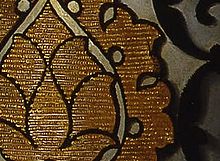Agnolo Bronzino’s Painting of Eleonora Di Toledo Is Categorized as Fine Art
| Portrait of Eleanor of Toledo and Her Son | |
|---|---|
| Italian: Eleonora di Toledo col figlio Giovanni | |
 | |
| Artist | Bronzino |
| Yr | circa 1545 |
| Type | Oil on panel |
| Dimensions | 115 cm × 96 cm (45 in × 38 in) |
| Location | Uffizi Gallery, Florence, Italy |
The Portrait of Eleanor of Toledo and Her Son is a painting by the Italian creative person Agnolo di Cosimo, known equally Bronzino, finished ca. 1545. Ane of his most famous works,[1] it is housed in the Uffizi Gallery of Florence, Italy and is considered one of the preeminent examples of Mannerist portraiture.[2] The painting depicts Eleanor of Toledo, the wife of Cosimo I de' Medici, Grand Knuckles of Tuscany, sitting with her hand resting on the shoulder of ane of her sons. This gesture, as well as the pomegranate motif on her dress, referred to her role as mother. Eleanor wears a heavily brocaded dress with black arabesques. In this pose, she is depicted as the platonic woman of the Renaissance.[3] The painting is the first known state-deputed portrait to include the ruler'south heir. By including the child, Cosimo wished to imply that his rule would bring stability to the duchy.[4]
The kid has been variously identified as being either Eleanor's son Francesco (born 1541), Giovanni (born 1543) or Garzia (born 1547). If the discipline is the latter, the portrait should exist dated around 1550–53, but the engagement is at present more often than not assigned to c. 1545, based on an examination of the evolution of Bronzino's mode, which would suggest Giovanni.[one]
The portrait has been called "cold", reflecting the sober formality of Eleanor's native Castilian Courtroom, without the warmth typically expected of a portrait of female parent and kid. Such distancing is typical of the Mannerist school'due south rejection of naturalism.[5] Conversely, Eleanor's gown of elaborate brocaded velvet, with its massed bouclé effects of gold weft loops in the style called riccio sopra riccio (loop over loop), is painstakingly replicated.[6] The painting is perhaps an ad for the Florentine silk industry, which had fallen in popularity in the starting time difficult years of the sixteenth century and was revived in the reign of Cosimo I. The precious golden belt, busy with jewels and chaplet with a tassel, may have been made by the goldsmith Benvenuto Cellini.
Article of clothing [edit]

Detail of the brocaded velvet.
Eleanor is depicted wearing a formal gown over a camisa or smock of linen trimmed with narrow bands of blackwork embroidery at the neck and sleeve ruffles. Bronzino'due south painting captures the dimensionality of the brocaded silk velvet material in the gown with its loops of golden-wrapped thread and black pile arabesques against a white satin ground. Vesture made of such rich textiles was reserved for official occasions and was not typical of Eleanor's everyday wardrobe, which featured solid-coloured gowns of velvets and satins.[7]
When Eleanor'south body was exhumed in the 19th century, some concluded she had been buried in the same dress every bit in the portrait.[1] An almost identical hairnet might have caused this defoliation. But newer research shows that she was cached in a much simpler white satin gown over a scarlet velvet bodice (and probably a matching petticoat, which has not survived).[8] [9] Afterward a long and complex restoration, the original wear has been conserved and detailed reconstructions are displayed in the Costume Gallery in the Palazzo Pitti, Florence. The original garments are much too fragile for public display.[10]
References [edit]
| External video | |
|---|---|
| |
- ^ a b c Thomas, Joe A. (1994). "Fabric and Dress in Bronzino's Portrait of Eleanor of Toledo and Son Giovanni". Zeitschrift für Kunstgeschichte. 57 (2): 262–67. doi:10.2307/1482735. JSTOR 1482735.
- ^ "Eleanor of Toledo with Her Son Giovanni". Britannica. Retrieved 21 April 2011. (subscription required)
- ^ Teplis, Michelle (2011), "The Ideal Woman behind a Portrait", Armstrong Undergraduate Journal of History, Armstrong Atlantic State University, ISSN 2163-8551, retrieved 16 December 2012
- ^ Bilik, Shiri (Spring 2002), "Women Who Ruled", Michigan Today, University of Michigan, archived from the original on 26 July 2013, retrieved 16 December 2012
- ^ a b "Bronzino'southward Portrait of Eleonora di Toledo with her son Giovanni". Smarthistory at Khan Academy. Retrieved 30 December 2012.
- ^ Monnas (2012), p. 20
- ^ "Way at the Medici Court: the conserved clothes of Cosimo, Eleonora and don Garzia – Florence, Galleria del Costume, Palazzo Pitti, June 25 – Dec 31, 1993 (exhibition catalogue)". Retrieved 31 December 2012.
- ^ Arnold (1985), p. 102
- ^ Landini (2005), p 70-74.
- ^ "Medici Archive". Retrieved xxx December 2012.
Sources [edit]
- Arnold, Janet (1985). Patterns of fashion three: The cut and construction of apparel for men and women, c. 1560–1620. London New York: Macmillan Drama Book. ISBN0896760839.
- Buticchi, Susanna. La Grande Storia dell'Arte. Cinquecento. Il Sole 24 Ore-Due east.ducation.it. Firenze.
- Landini, Roberta Orsi; Bruna, Niccola (2005). Moda a Firenze 1540–1580: Lo stile di Eleonora di Toledo e la sua influenza. Italy: Mauro Pagliai.
- Monnas, Lisa (2012). Renaissance Velvets. London New York: Five&A Pub. Distributed in Northward America by Harry Due north. Abrams. ISBN9781851776566.
Source: https://en.wikipedia.org/wiki/Portrait_of_Eleanor_of_Toledo
0 Response to "Agnolo Bronzino’s Painting of Eleonora Di Toledo Is Categorized as Fine Art"
Post a Comment